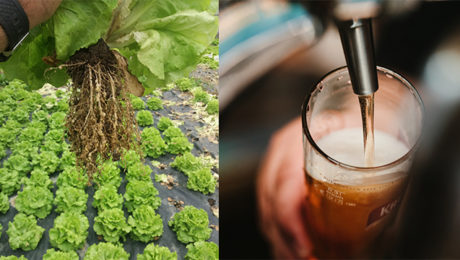Alcohol Levels in Wine Continue to Rise
The alcohol levels in wine have been rising over the past 30 years — and wine experts say the sugar content in grapes is to blame.
Though a winemaker can manipulate sugar levels in the vineyard and alcohol levels in the cellar, a hotter climate is driving increased sugar content in grapes. California’s wine grapes have had a “substantial rise” in sugar levels since 1980. A study by the American Association of Wine Economists (AAWE) hypothesizes global warming is contributing.
Read more (Decanter)
- Published in Food & Flavor
Fermented Fungi Forge Forward
The alternative protein industry continues to explode in growth — and fermented mushrooms are leading the pack as the preferred meatless protein. In a recent article, the World Economic Forum highlighted mycoprotein, the protein-rich, flavorless “foodstuff” made from fermenting mushrooms. Companies creating alt proteins with fungi “are starting to sprout almost overnight,” the article notes.
Mycoprotein has a big advantage over plant-based proteins, as it has a meat-like texture that can then be flavored to taste like animal meat. Plant proteins must go through further processing to replicate a meat-like texture, and many plant proteins retain the taste of the original plant.
The mycoprotein production process was developed and patented by UK brand Quorn in 1985. But their patent expired in 2010, and the food technology is now available for all.
Read more (World Economic Forum)
- Published in Business, Food & Flavor, Science
The State of the Art in Coffee Fermentation
More specialty coffee producers are developing unique approaches to their coffee bean fermentation, isolating native microorganisms to create a flavorful cup or working closely with rural farmers to utilize fermentation control techniques on small-scale operations.
“Practically all the coffee we drink has been fermented in one way or another. But there is huge room for improvement, innovation and development in the realm of coffee fermentation,” says Mario Fernández, PhD, Technical Officer with the Specialty Coffee Association (SCA). The SCA partnered with The Fermentation Association for the webinar The State of the Art in Coffee Fermentation.
Fernández continues: “Coffee is produced by millions of small coffee producers around the tropics that have very little capital to invest in fermentation equipment. Oftentimes, the price is too low for them to add fermentation controls as part of the cost equation. Therefore, for perhaps 99.9% of coffee in the world, it undergoes wild fermentation, in which the microbes grow on the mass of mucilage in a wild fashion and the coffee producer only controls certain parameters, such as the length of the fermentation.”
Two industry experts on the forefront of coffee fermentation technique and technology joined Fernández — Felipe Ospina, CEO of Colors of Nature Group (multinational specialty coffee trader) and Rubén Sorto, CEO of BioFortune Group (a coffee, upcycled and food ingredient manufacturer based in Honduras).
Post Harvest Processing Technology
Sorto is adapting fermentation technology to coffee, mapping the microbiota of the bacteria and yeasts that are present at Biofortune Group’s farms.
“We realized that fermentation was one of the key aspects of the coffee production that hadn’t been addressed,” Sorto said, noting fermentation is controlled in industries like dairy, wine, beer and bread but not in coffee. “We learned that our soil, our water, our coffee trees, our leaves, our [coffee] cherries, had a large compendium of bacteria and yeast that were involved in the posterior fermentation process…some of the yeasts and bacteria were definitely beneficial and were urgently needed during the fermentation but some of them were not.”
To maximize flavor, they focus on that complex array of bacteria and yeasts, preferably indigenous to the countries of origin. These microorganisms thrive in their local environment, reflecting altitude and temperature. To control the fermentation of those bacteria and yeasts, Biofortune reduces the variables, including monitoring pH levels, alcohol content and container contaminants.
“If you are able to control the fermentation, you are also able to offer a higher-quality product, a consistent quality product…and that’s what the market is looking for, consistent quality in a cup,” Sorto says.
Educating Coffee Farmers
Ospina, meanwhile, is researching fermentation techniques accessible to small-holder coffee producers and training them. The goal is for them to understand the role of each microorganism, discover how to use it in fermentation, then scale that knowledge to small-scale operations, so they can produce incredible coffees.
At La Cereza Research Center, the Colors of Nature facility in southern Colombia, they are experimenting with fermentation processes. Some alcoholic fermentations result in coffees that produce coffees that taste of whiskey, cognac, champagne, sangria or even beer. Lactic fermentations might produce coffees with flavors of banana, mango, papaya, grapefruit or even cacao. “This is showing us the potential is humongous,” Ospina says.
“Wild fermentation is the ultimate expression of the terroir and it’s very important for us because the terroir produces unique coffees,” Ospina says. “The thing is, we don’t understand wild fermentation yet, but I’m very against demonizing wild fermentation. Why? Because we have seen hundreds and hundreds of outstanding, amazing coffees from all over the world that have been produced with wild fermentation.”
There are challenges. Food safety is a big concern. Ospina teaches the use of disposable gloves at the farm level to prevent contaminants, and to put a new plastic bag in the bioreactor for each batch of beans to avoid cross-contamination.
The cost of implementing fermentation technology can be high. Sorto recommends to start by buying each farmer a pocket pH meter and a refractometer to closely monitor the fermentation.
“Translating science and technology to small farmers with very little investment will help them increase the possibility of a higher income because if you are not able to control fermentation, you are risking the effort of a one year harvest,” Sorto advises.
- Published in Business, Food & Flavor
Beyond Kombucha: Pu’erh, Jun and Dark Tea
Tea consumption globally is increasing. But consumers don’t want a cheap, poor quality tea bag. They’re buying premium teas — and increasingly, dark, fermented teas.
“What’s trending right now seems to be authentic tea, tea that has great flavor, more closely married to the terroir. People are beginning to understand that it’s just fine to have tea. You don’t have to have coloring in it, you don’t have to have a lot of bits and pieces of fruit and flowers, there’s a genuine benefit to just understanding the terroir and keeping it simple,” says Dan Bolton, the founder, editor and publisher of Tea Journey. Bolton and two tea experts discussed two lesser-known fermented tea varieties in the TFA webinar Beyond Kombucha: Pu’erh, Jun and Dark Tea. “Tea just isn’t as good as it could be, without fermentation.”
A new study on tea demonstrates how important fermentation is to tea quality, Bolton says. Researchers from the Anhui Agricultural University in China recently studied the effect of surface microbiomes on the quality of black tea. The results found microbial fermentation in non-sterilized control tea samples produced complex compounds and more flavorful teas than with sterilized tea leaves. The results were published in the Journal of Agricultural and Food Chemistry.
“It’s a remarkable finding because, certainly for the last century or so, there’s been a lot of discussion about whether fermentation plays a role in the production and processing of tea,” Bolton says. The study proves “black tea is actually a result of both fermentation and oxidation.”
Pu’erh Tea
Jeff Fuchs — author, Himalayan explorer and co-founder of Jalam Teas — shared details of pu’erh tea. Pu’erh is a tea style from a strain of camellia leaf cultivated and produced in the Yunnan province. Fuchs spent over a decade living in there and is the only Westerner to have traveled the Tea Horse Road through Sichuan, Yunnan and Tibet.
“Pu’erh is a tea that certainly I think it’s been deliberately mystified to some degree,” Fuchs says. “It’s interesting that you have this very simple, raw material green tea that is now arguably one of the great boutique commodities.”
Fuchs stresses consumers need to research tea sourcing. Where is the tea coming from? How was it stored? Who stored it? Older tea cakes are being sold for large amounts of money, but can have questionable provenance.
“Young teas I think are making a big assertion in the tea world right now because they represent a closer line to the terroir, a closer line to the origin point,” he says, adding dark teas are becoming more popular in North America. He sees more bartenders experimenting with dark teas, playing with flavor compounds. “I think dark teas will come into the sway more and they’ll remain.”
Jun Tea
Jun is another tea style making waves in the fermented beverage market. It is a type of kombucha, but the base is green tea and honey instead of black tea and sugar. Brendan McGill shared his experience making jun — he is a chef and James Beard nominee; he owns the Hitchcock Restaurant Group in Seattle and the newly-launched Junbug Kombucha.
“Jun is a very special style of kombucha,” McGill says. “It’s shrouded in mystery, where these cultures originated. What we do know is how they’ve been developed and manipulated in fairly recent history. One of the joys I’ve had with this is just being extremely creative because i found that while the fermentation isn’t necessarily a delicate process, it has allowed us to modify and use a lot of different inputs that it’s actually a pretty robust fermentation process.”
McGill began making kombucha over a decade ago, as a replacement for beer and wine. He liked jun for its similar flavor to alcohol, the additional bioactive compounds that create a more nutritious drink and it’s made with honey instead of added sugar.
Junbug Kombucha uses filtered water, organic green tea, wild honey and, of course, a SCOBY. In the secondary fermentation, fresh herbs, berries and even mushrooms are added. Junbug flavors include Chaga Root Beer, Chili Raspberry and Maui Mana.
- Published in Business, Food & Flavor
Managing Fermented Food Microbes to Control Quality
Fermented foods are produced through controlled microbial growth — but how do industry professionals manage those complex microorganisms? Three panelists, each with experience in a different field and at a different scale — restaurant chef, artisanal cheesemaker and commercial food producer — shared their insights during a TFA webinar, Managing Fermented Food Microbes to Control Quality.
“Producers of fermented foods rely on microbial communities or what we often call microbiomes, these collections of bacteria yeasts and sometimes even molds to make these delicious products that we all enjoy,” says Ben Wolfe, PhD, associate professor at Tufts University, who moderator the webinar along with Maria Marco, PhD, professor at University of California, Davis (both are TFA Advisory Board members).
Wolfe continued: “Fermenters use these microbial communities every day right, they’re working with them in crocks of kimchi and sauerkraut, they’re working with them in a vat of milk as it’s gone from milk to cheese, but yet most of these microbial communities are invisible. We’re relying on these communities that we rarely can actually see or know in great detail, and so it’s this really interesting challenge of how do you manage these invisible microbial communities to consistently make delicious fermented foods.”
Three panelists joined Wolfe and Marco: Cortney Burns (chef, author and current consultant at Blue Hill at Stone Barns in New York, a farmstead restaurant), Mateo Kehler (founder and cheesemaker at Jasper Hill in Vermont, a dairy farm and creamery) and Olivia Slaugh (quality assurance manager at wildbrine | wildcreamery in California, producers of fermented vegetables and plant-based dairy).
Fermentation mishaps are not the same for producers because “each kitchen is different, each processing facility, each packaging facility, you really have to tune in to what is happening and understand the nuance within a site,” Marco notes. “Informed trial and error” is important.
The three agreed that part of the joy of working in the culinary world is creating, and mistakes are part of that process.
“We have learned a lot over the years and never by doing anything right, we’ve learned everything we know by making mistakes,” says Kehler.
One season at Jasper Hill, aspergillus molds colonized on the rinds of hard cheeses, spoiling them. The cheesemakers discovered that there had been a problem early on as the rind developed. They corrected this issue by washing the cheese more aggressively and putting it immediately into the cellar.
“For the record, I’ve had so many things go wrong,” Burns says. A koji that failed because a heating sensor moved, ferments that turned soft because the air conditioning shut off or a water kefir that became too thick when the ferment time was off. “[Microbes are] alive, so it’s a constant conversation, it’s a relationship really that we’re having with each and every one on a different level, and some of these relationships fall to the wayside or we forget about them or they don’t get the attention they need.”
Burns continues: “All these little safeguards need to be put in place in order for us to have continual success with what we’re doing, but we always learn from it. We move the sensor, we drop the temperature, we leave things for a little bit longer. That’s how we end up manipulating them, it’s just creating an environment that we know they’re going to thrive in.”
Slaugh distinguishes between what she calls “intended microbiology” — the microbes that will benefit the food you’re creating — and “unintended microbiology” — packaging defects, spoilage organisms or a contamination event.
Slaugh says one of the benefits of working with ferments at a large scale at wildbrine is the cost of routine microbiological analysis is lower. But a mistake is stressful. She recounted a time when thousands of pounds of food needed to be thrown out because of a contaminant in packaging from an ice supplier.
“Despite the fact that the manufacturer was sending us a food-grade or in some cases a medical-grade ingredient, the container does not have the same level of sanitation, so you can’t really take these things for granted,” Slaugh says.
Her recommendations include supplier oversight, a quality assurance person that can track defects and sample the product throughout fermentation and a detailed process flow diagram. That document, Slaugh advises, should go far beyond what producers use to comply with government food regulations. It should include minutiae like what scissors are used to cut open ingredient bags and the process for employees to change their gloves.
“I think this is just an incredible time to be in fermented foods,” Kehler adds. “There’s this moment now where you have the arrival of technology. The way I described being a cheesemaker when I started making cheese almost 20 years ago was it was like being a god, except you’re blind and dumb. You’re unleashing these universes of life and then wiping them out and you couldn’t see them, you could see the impacts of your actions, but you may or may not have control. What’s happened since we started making cheese is now the technology has enabled us to actually see what’s happening. I think it’s this groundbreaking moment, we have the acceleration of knowledge. We’re living in this moment where we can start to understand the things that previously could only be intuited.”
- Published in Food & Flavor, Science
Natural Production Changing the Wine Industry
Natural winemaking is moving mainstream, as more viticulturists preach the importance of soil health and shun traditional herbicides. “Where does natural wine finish and conventional wine start? These days, it’s hard to tell,” reads an article in Vinepair. Though the vast majority of global wine production still relies on conventional methods, the virtues of natural winemaking are helping change the industry.
“While it used to be rare for wines to be fermented with wild yeast — allowing the microbes present on the grapes to carry out fermentation — this is now much more common. And conventional producers have been prompted to question their use of additives such as sulfur dioxide. In fact, many aspects of winemaking that were championed by natural wine folk have now become much more common, even replacing some of the triumphs of more heavy-handed methods. As more producers trend away from making big, international-style reds with dark color, sweet fruit, high alcohol, and obvious new oak character, extracting less color and tannin for lighter-style reds is gaining popularity.”
Read more (Vinepair)
- Published in Food & Flavor
Which Are Healthier — Fermented or Acidified Pickles?
Researchers with the USDA have found that fermented cucumber pickles contain more of the naturally-occurring gamma-aminobutyric acid (GABA) than do their acidified counterparts. Results of this study of commercially-available pickles were recently published in the Journal of Food Composition and Analysis.
GABA works as a neurotransmitter in the brain. It has been scientifically proven that GABA, when consumed in foods or supplements, reduces blood pressure, improves decision making, reduces anxiety and boosts immunity.
Fermented cucumber pickles undergo a lactic acid fermentation, whereas acidified cucumber pickles are submerged in an acidic brine. The fermented pickles with the most GABA were made in a low-salt fermentation, and the products were prepared for direct consumption. GABA content also was found to remain stable during storage for fermented cucumbers.
“Worldwide, people are interested in consuming fermented foods as part of a healthy lifestyle. Most often, we associate the healthfulness of fermented foods with probiotic microbes. But many fermented foods contain few to no microbes when consumed,” said Jennifer Fideler Moore, North Carolina State University graduate research assistant and one of the study co-authors, in a USDA-ARS press release. “Our research shows that the health-promoting potential of lactic acid fermented cucumbers reaches far beyond the world of probiotics. This opens the door to more research into health-promoting compounds made during fermentation of fruits and vegetables.”
Adds Suzanne Johanningsmeier, study co-author and USDA Agricultural Research Service (USDA-ARS) Research Food Technologist: “Fruits and vegetables are made up of thousands of unique molecules. These molecules rule the flavor, texture, and nutritional value, but it is difficult to study them in such complex systems. To tackle this problem, we use advanced analytical chemistry techniques like mass spectrometry to study food molecules and figure out the best food processing methods for improved quality of fruit and vegetable products.”
[Johanningsmeier presented further details of the study during a TFA webinar.]Farming with Beer Waste
In a study published in Frontiers in Sustainable Food Systems, researchers detail how they have created an eco-friendly pesticide using beer bagasse (spent beer grains), rapeseed cake (byproduct of oil extraction from seeds) and fresh cow manure.
Chemical pesticides have been proven harmful to the environment, damaging soil and water. Pesticides are also easily consumed, and many studies link their use to multiple diseases and birth defects. Researchers from the Neiker Basque Institute for Agricultural Research and Development in Spain hope that farmers will use these organic byproducts from beer production to kill parasites, preserve healthy soil and increase crop yields.
Read more (Frontiers Science News)
- Published in Science
Best Practices for Cash Flow Management
Running a food or drink business is challenging in today’s market — there’s increasing competition, fast-paced trends and challenging access to retailers. If you run a fermentation-based business with a long production cycle, those market forces are compounded.
“A lot of businesses in this sector are in it because of the passion, they love what they’re doing, and sometimes the finances can feel very mysterious, there’s an aversion to dealing with it, and they aren’t taking the time to really look and understand the numbers,” says Maria Pearman, a principal with Perkins & Co., Portland, OR-based professionals in food and beverage finance and accounting. She shared her expertise during a TFA webinar, Best Practices for Cash Flow Management.
“Cash flow forecasting, it’s not rocket science. It’s not hard stuff. It is just very foreign to a lot of people and they avoid it,” Pearman says.
Matt Hately, a TFA Advisory Board member who moderated the webinar, agreed. Hately is an investor and advisor in fermented food and beverage brands.
“Managing cash…I would argue that it’s even more of a challenge for fermentation companies where your production cycles aren’t instant, they might take a week or three weeks or six weeks and, when you’re starting, your suppliers are probably demanding to be paid up front, your customers want 30-day terms,” he says .
Fermented Financials
Pearman, author of the book Small Brewery Finance, shared an overview on cash management. Fermentation businesses need to closely manage their cash conversion cycle as production cycles lengthen. The cash flow conversion cycle is the period between when money is spent to purchase ingredients to when payment is received from the sale of the final product.
Fermented products — which can take anywhere from a few weeks to even years to ferment — have a long cycle.
Pearman shared the example of a whisky distiller. After fermentation, whisky ages in barrels for years. All the while — before the product is ever sold — there are ongoing overhead costs for the distillery, like rent, utilities and staff.
“The rhythm of your cash flow is not going to match the rhythm of your income, and cash flow management is about bridging that gap,” Pearman says.
Cash Flow Forecasting
There are three primary financial reports that make up a business’ financial statements:
- Balance sheet (snapshot of the status of a company at a moment in time)
- Income statement (performance over a period of time)
- Statements of cash flows (sources and uses of cash over a period of time)
Often overlooked is cash flow forecasting, the expected inflow and outflow of cash over future periods.
The cash flow forecast, Pearman notes, is not standard in business financial records. It is usually kept outside of an accounting system as it’s information management generally uses. It’s important because a business can’t rely on just their income statement or bank balance to manage cash flow — labor, overhead and cost of inventory must be part of the expenses. She compared managing cash without a cash flow forecast to “building a house without a hammer.”
“One of the biggest pitfalls that I see with businesses is chasing profitability instead of cash flow,” Pearman says. “It is completely understandable because we’re all hardwired to try to do things as efficiently as we can, get the best deal, but truly in the early stages of a company, it’s way more important to manage cash flow than profitability.”
“It’s a high cost for bringing a new product to market. Cash flow issues are going to be prevalent regardless of where you are in your life cycle, and the best way to guard against cash issues is to have a cash flow forecast.”
During the webinar, Pearman shared a detailed look at a sample business’ financial workbook. She noted that it seems arduous to manage that level of detail but, without it, “you’re really flying blind.”
“It will force you to be highly in tune with the rhythms of your business,” she continues. “It will force you to learn it at such a level that it starts to become innate knowledge, you know it like the back of your hand and there’s no shortcut to that.”
View Pearman’s video presentation, companion presentation and companion spreadsheet.
- Published in Business










